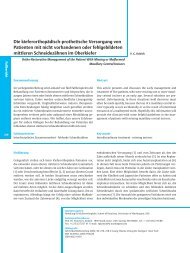altering vertical dimension in the perio-restorative patient - Kokich ...
altering vertical dimension in the perio-restorative patient - Kokich ...
altering vertical dimension in the perio-restorative patient - Kokich ...
Create successful ePaper yourself
Turn your PDF publications into a flip-book with our unique Google optimized e-Paper software.
2 ALTERING VERTICAL DIMENSION IN THE PERIO-RESTORATIVE PATIENT • <strong>Kokich</strong><br />
PHILOSOPHY AND BACKGROUND<br />
In <strong>the</strong> past decade, <strong>the</strong> number of adults seek<strong>in</strong>g orthodontic treatment has grown substantially.<br />
Today, <strong>in</strong> most orthodontic practices, 30% to 50% of <strong>patient</strong>s <strong>in</strong> active orthodontic treatment<br />
are adults. My practice is devoted completely to adults. Although adolescent and adult malocclusions<br />
are similar, adults usually have additional problems that make <strong>the</strong>ir treatment more challeng<strong>in</strong>g.<br />
One of <strong>the</strong> most destructive is anterior tooth wear comb<strong>in</strong>ed with compensatory<br />
eruption of <strong>the</strong> abraded teeth. When this type of <strong>patient</strong> is referred to me by a <strong>restorative</strong> dentist,<br />
<strong>the</strong> common request from <strong>the</strong> cl<strong>in</strong>ician is to “open <strong>the</strong> <strong>vertical</strong>” to allow adequate restoration<br />
of <strong>the</strong> teeth. What does “open <strong>the</strong> <strong>vertical</strong>” mean to you? What should it mean to <strong>the</strong><br />
orthodontist with whom you are collaborat<strong>in</strong>g? Actually, <strong>the</strong>re may be a dist<strong>in</strong>ct difference <strong>in</strong><br />
what is necessary and what is orthodontically possible <strong>in</strong> an adult <strong>patient</strong> with worn and/or<br />
abraded anterior teeth. Although some cl<strong>in</strong>icans believe that <strong>patient</strong>s with anterior tooth wear<br />
are “overclosed” and need to have <strong>the</strong>ir <strong>vertical</strong> <strong>dimension</strong> <strong>in</strong>creased, this diagnosis and <strong>the</strong><br />
result<strong>in</strong>g treatment plan are usually <strong>in</strong>appropriate. The problem typically is compensatory<br />
eruption of <strong>the</strong> anterior teeth, secondary to <strong>in</strong>cisal wear. The problem for <strong>the</strong> <strong>restorative</strong> dentist<br />
is <strong>in</strong>sufficient space to restore <strong>the</strong>se teeth without fur<strong>the</strong>r tooth reduction, possible crown<br />
leng<strong>the</strong>n<strong>in</strong>g, and perhaps root canal <strong>the</strong>rapy. However, orthodontists can <strong>in</strong>trude <strong>the</strong> maxillary<br />
<strong>in</strong>cisors, mandibular <strong>in</strong>cisors, or both <strong>in</strong> order to create <strong>restorative</strong> space, move <strong>the</strong> g<strong>in</strong>gival<br />
marg<strong>in</strong>s apically, and elim<strong>in</strong>ate <strong>the</strong> need for fur<strong>the</strong>r tooth reduction. The team of orthodontist<br />
and <strong>restorative</strong> dentist must decide which teeth are to be <strong>in</strong>truded, how long <strong>the</strong>y are to be held<br />
<strong>in</strong> position, and how this type of tooth movement will affect <strong>the</strong> <strong>patient</strong>’s es<strong>the</strong>tic appearance.<br />
2<br />
UUSING MAXILLARY AND MANDIBULAR<br />
INTRUSION TO CREATE RESTORATIVE SPACE:<br />
FOUR GUIDING PRINCIPLES<br />
One of <strong>the</strong> most perplex<strong>in</strong>g problems for general dentists is how to manage <strong>restorative</strong> treatment<br />
for <strong>the</strong> adult <strong>patient</strong> with a deep anterior overbite. In most cases, <strong>the</strong>re is little or no<br />
room to prepare <strong>the</strong> anterior teeth adequately, and creat<strong>in</strong>g space for <strong>restorative</strong> materials<br />
often requires significant reduction of <strong>the</strong> exist<strong>in</strong>g teeth. Moderate to extensive wear or abrasion<br />
of <strong>the</strong> maxillary and/or mandibular <strong>in</strong>cisors fur<strong>the</strong>r complicates <strong>the</strong> overbite problem.<br />
As <strong>the</strong>se teeth wear, <strong>the</strong>y usually cont<strong>in</strong>ue to erupt, br<strong>in</strong>g<strong>in</strong>g <strong>the</strong> bone and g<strong>in</strong>giva with <strong>the</strong>m.<br />
In order to restore <strong>the</strong>se short teeth, <strong>the</strong> <strong>restorative</strong> dentist typically considers two possible<br />
treatment plans. One option <strong>in</strong>volves crown leng<strong>the</strong>n<strong>in</strong>g of <strong>the</strong> short abraded teeth, followed<br />
by potential root canal <strong>the</strong>rapy, post and core buildups, and eventual restoration of <strong>the</strong> teeth.<br />
Ano<strong>the</strong>r option is to open <strong>the</strong> <strong>patient</strong>’s <strong>vertical</strong> <strong>dimension</strong> by restor<strong>in</strong>g most of <strong>the</strong> posterior<br />
teeth <strong>in</strong> order to ga<strong>in</strong> <strong>the</strong> space needed to restore <strong>the</strong> anterior teeth. However, <strong>the</strong>re is a third possibility—orthodontics<br />
and/or orthognathic surgery. Orthodontists can <strong>in</strong>trude maxillary and<br />
mandibular anterior teeth to create <strong>restorative</strong> space. In some situations, orthognathic surgery of<br />
<strong>the</strong> mandible and/or maxilla can open <strong>the</strong> <strong>patient</strong>’s anterior <strong>vertical</strong> <strong>dimension</strong> to improve facial<br />
es<strong>the</strong>tics and provide <strong>restorative</strong> space. This chapter presents and illustrates <strong>the</strong> govern<strong>in</strong>g pr<strong>in</strong>ciples<br />
and <strong>the</strong> diagnostic techniques required to correctly analyze and prescribe <strong>the</strong> appropriate<br />
treatment for <strong>the</strong>se types of problems.





